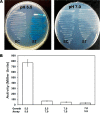Characterization of an acid-inducible sulfatase in Salmonella enterica serovar typhimurium
- PMID: 23315743
- PMCID: PMC3592217
- DOI: 10.1128/AEM.03707-12
Characterization of an acid-inducible sulfatase in Salmonella enterica serovar typhimurium
Abstract
Sulfatases of enteric bacteria can provide access to heavily sulfated mucosal glycans. In this study, we show that aslA (STM0084) of Salmonella enterica serovar Typhimurium LT2 encodes a sulfatase that requires mildly acidic pH for its expression and activity. AslA is not regulated by sulfur compounds or tyramine but requires the EnvZ-OmpR and PhoPQ regulatory systems, which play an important role in pathogenesis.
Figures



Similar articles
-
Dopamine-induced sulfatase and its regulator are required for Salmonella enterica serovar Typhimurium pathogenesis.Microbiology (Reading). 2019 Mar;165(3):302-310. doi: 10.1099/mic.0.000769. Epub 2019 Jan 16. Microbiology (Reading). 2019. PMID: 30648943
-
Sugar sulfates are not hydrolyzed by the acid-inducible sulfatase AslA from Salmonella enterica Enteritidis NalR and Kentucky 3795 at pH 5.5.Can J Microbiol. 2017 Aug;63(8):739-744. doi: 10.1139/cjm-2017-0059. Epub 2017 May 30. Can J Microbiol. 2017. PMID: 28558253
-
SlyA and HilD Counteract H-NS-Mediated Repression on the ssrAB Virulence Operon of Salmonella enterica Serovar Typhimurium and Thus Promote Its Activation by OmpR.J Bacteriol. 2019 Mar 26;201(8):e00530-18. doi: 10.1128/JB.00530-18. Print 2019 Apr 15. J Bacteriol. 2019. PMID: 30718301 Free PMC article.
-
Delineation of upstream signaling events in the salmonella pathogenicity island 2 transcriptional activation pathway.J Bacteriol. 2004 Jul;186(14):4694-704. doi: 10.1128/JB.186.14.4694-4704.2004. J Bacteriol. 2004. PMID: 15231802 Free PMC article.
-
OmpR regulates the stationary-phase acid tolerance response of Salmonella enterica serovar typhimurium.J Bacteriol. 2000 Apr;182(8):2245-52. doi: 10.1128/JB.182.8.2245-2252.2000. J Bacteriol. 2000. PMID: 10735868 Free PMC article.
Cited by
-
Resistance and virulence determinants of faecal Salmonella spp. isolated from slaughter animals in Benin.BMC Res Notes. 2019 Jun 7;12(1):317. doi: 10.1186/s13104-019-4341-x. BMC Res Notes. 2019. PMID: 31174590 Free PMC article.
-
Genetic Variation and Preliminary Indications of Divergent Niche Adaptation in Cryptic Clade II of Escherichia.Microorganisms. 2020 Oct 31;8(11):1713. doi: 10.3390/microorganisms8111713. Microorganisms. 2020. PMID: 33142902 Free PMC article.
References
-
- Majowicz SE, Musto J, Scallan E, Angulo FJ, Kirk M, O'Brien SJ, Jones TF, Fazil A, Hoekstra RM, International Collaboration on Enteric Disease “Burden of Illness” Studies 2010. The global burden of nontyphoidal Salmonella gastroenteritis. Clin. Infect. Dis. 50:882–889 - PubMed
-
- Sonnenburg JL, Xu J, Leip DD, Chen CH, Westover BP, Weatherford J, Buhler JD, Gordon JI. 2005. Glycan foraging in vivo by an intestine-adapted bacterial symbiont. Science 307:1955–1959 - PubMed
Publication types
MeSH terms
Substances
Grants and funding
LinkOut - more resources
Full Text Sources
Other Literature Sources
Molecular Biology Databases

